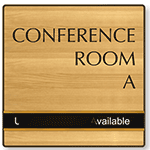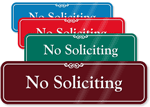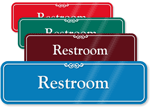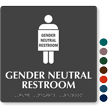The gender-neutral restroom debate: right or privilege?
Earlier this month, the vote to pass the Employment Non-Discrimination Act marked the first time in history a transgender employment non-discrimination bill passed in the Senate. The bill’s approval is a huge step toward equality for gay, lesbian, bisexual, transgender, and questioning workers. The question that needs to be asked going forward is: How will employers adjust to support LGBTQ individuals?
Those outside the LGBTQ community may not be familiar with the discrimination these employees face. A study conducted by the Williams Institute at the University of California Los Angeles School of Law provided detailed examples of harassment of LGBTQ employees in the workplace and 90% of transgender respondents reported experiencing mistreatment at work. Unfortunately, only 15 percent of those who reported discrimination filed a complaint out of fear of “outing” themselves further.
Gender-neutral restrooms are one method to assure LGBTQ employees they are welcome and equal in the workplace. Gender-neutral restrooms are restrooms anyone can use. While most people take comfortable access to restrooms for granted, transgender people may face confrontation over which bathroom they should use. Restrooms should serve as a safe place for all employees.
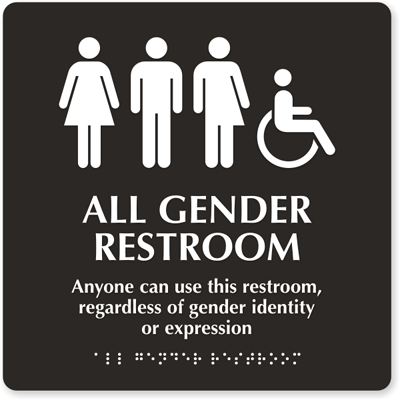
Signs available at MyDoorSign.
The Office of Personnel Management, a federal agency that enforces civil service laws, set the following guidelines: “Once (a transgender employee) has begun living and working full-time in the gender that reflects his or her identity, agencies should allow access to restrooms…consistent with his or her gender identity.”
Bathroom safety can be a concern for transgender people because it’s a private place where they might not be able to seek help if a conflict arises. Seven to 41 percent of LGBTQ workers were verbally or physically abused at work. All-gender bathrooms may serve as a solution to such workplace conflict.
Recently, the popular comedy news program The Colbert Report discussed our All-Gender bathroom signs. Stephen Colbert quoted the Family Research Council, a conservative Christian group, as saying that “…restrooms and locker rooms could become landmines for disputes and disturbances. An anatomically male employee who claims a female gender identity might be able to demand access to the women’s restroom.”
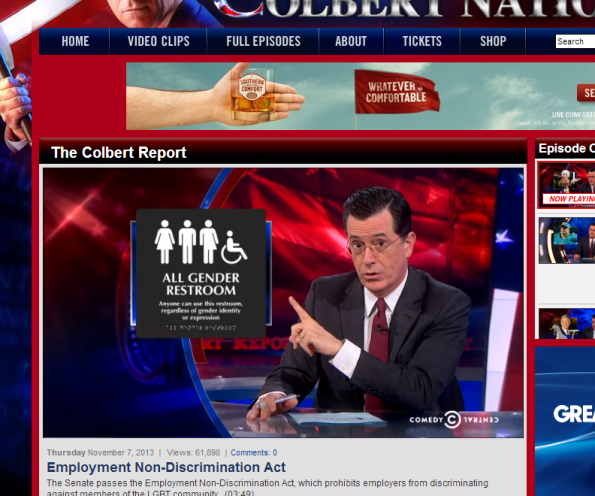
MyDoorSign’s All Gender Restroom Sign on The Colbert Report.
Mildred Ramos, Deputy Executive Director of Operations at the Ali Forney Center disagrees, saying “We strongly feel that creating gender-neutral signs/restrooms helps our community better acknowledge and accept diverse gender expressions. Similarly, we feel that gender normative approaches, such as male and female gender signs, can create serious conflicts for those who are struggling with their gender expression.” The Ali Forney Center places New York City’s homeless LGBTQ youth in safe, homelike environments.
In October, Philadelphia passed a new law requiring all new, city-owned buildings to be equipped with gender-neutral restrooms. The mandate also made Philadelphia the first U.S. city to provide tax credits to businesses that offer LGBT-inclusive benefits. As the bill’s sponsor, Councilman Jim Kenney, explained, “It can be an awkward and embarrassing situation (for those who) feel more like a woman, but can’t use the women’s room.” Elsewhere, gender-neutral restrooms remain an option some favor, while others remain strongly in opposition.
The gender-neutral bathroom debate also challenges organizations’ intentions: are they after political correctness or good public-relations karma? The Rocket, student newspaper of Slippery Rock University in Slippery Rock, PA, recently published an opinion column in which the writer argued that designating a restroom as gender neutral is simply a publicity stunt. According to the column, “It’s something that was likely sent to everybody in a “Good News” email from the PR department.” Even if that’s true, gender-neutral bathrooms are becoming a reality and benefitting LGBTQ people.
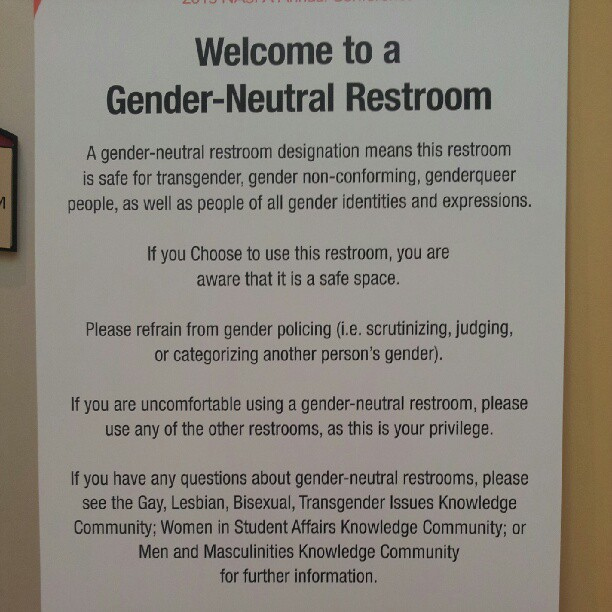
via Bryan Alexander
Dr. Jillian T. Weiss, professor of Law and Society at Ramapo College of New Jersey, does not see gender-neutral bathrooms as a necessity, but appreciates their significance. “Section 8(b) of the (Employment Non-Discrimination Act) specifically states that new construction is not required. However, workplaces … which have a transgender population, may wish to designate such a bathroom,” she told us. “Bathrooms that are single-use facilities may easily be designated as gender neutral. These would give comfort to transgender employees or potential employees who have concerns about using a single sex facility.”
Opponents have plenty of arguments as to why all gender bathrooms are unnecessary: gender-neutral bathrooms are a so-called “special privilege” for transgender people; men and women shouldn’t be forced to share a bathroom; it makes some people uncomfortable; it’s too expensive, there’s not enough space; and so on. Every argument has a rebuttal, but the bottom line is, each employer decides what’s right for their business (unless you work in Philadelphia in a city-owned building).
So, while gender-neutral bathrooms are not a requirement, adding a third option takes nothing away from those who prefer to use the men’s or women’s restroom, but can make a world of difference for those who want to avoid questions about their choice of gendered bathroom. Using the restroom is not a privilege, it’s a right.
-
All-Gender Restroom Signs
Category: Restrooms



